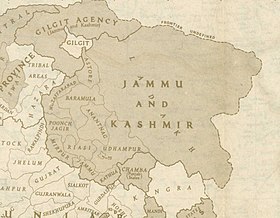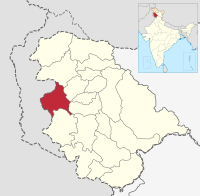
Mirpur, officially known as New Mirpur City, is the capital of Mirpur district located in Azad Kashmir, Pakistan which has been subject of the larger Kashmir dispute between Pakistan and India since 1947. It is the second largest city of Azad Kashmir and the 74th largest city in Pakistan.

Bagh District is a district of Pakistan-administered Azad Kashmir in the disputed Kashmir region. It is one of the ten districts of Azad Jammu and Kashmir. Previously part of Poonch District, Bagh was established as a separate district in 1988.

Poonch District is a district of Pakistan-administered Azad Kashmir in the disputed Kashmir region. It is one of the 10 districts of this Pakistan-administered territory. It is bounded on the north by Bagh District, on the north-east by Haveli District, on the south-east by the Poonch District of Indian-administered Kashmir, on the south by Azad Kashmir's Sudhanoti and Kotli districts, and on the west by Rawalpindi District of Pakistan's Punjab Province. The Poonch District is part of the greater Kashmir dispute between India and Pakistan. The district headquarters is the city of Rawalakot. It is the third most populous district of Azad Kashmir.

Uri is a town and a tehsil in the Baramulla district, in the Indian union territory of Jammu and Kashmir. Uri is located on the left bank of the Jhelum River, about 10 kilometres (6.2 mi) east of the Line of Control with Pakistan.

Maharaja Gulab Singh Jamwal (1792–1857) was the first Maharaja of Jammu and Kashmir and the founder of the Dogra dynasty. Originally a commander of the Sikh Empire, he sided with the British in the First Anglo-Sikh War and briefly became prime minister of the Sikh Empire in 1846. In the same year he signed the Treaty of Amritsar with the British, establishing the state of Jammu and Kashmir under the suzerainty of the British Raj; this treaty formalized the transfer of all lands that were ceded by the Sikhs to the British in the Treaty of Lahore.

Rajouri is a district in the Jammu division of Indian Jammu and Kashmir in the disputed Kashmir region. The Line of Control, between the Indian- and Pakistani-administered Jammu and Kashmir, lies to its west, Poonch to its north, the Reasi district to the east and the Jammu district to its south. Rajouri is famous for its "Kalari". Representing an ancient principality, Rajouri was a joint district, along with Reasi, at the time of princely state's accession to India in 1947. The two tehsils were separated and Rajouri was merged with the Poonch district. Rajouri again became a separate district along with Reasi in 1968 till 2006 when both were separated again. The Rajouri district comprises 13 tehsils (boroughs). The land is mostly fertile and mountainous. Maize, wheat and rice are the main crops of the area and the main source of the irrigation is the river Tawi that originates from the mountains of Pir Panjal.

Rajouri or Rajauri is a city in the Rajouri district in the Jammu division of the Indian union territory of Jammu and Kashmir. It is located about 155 kilometres (96 mi) from Srinagar and 150 km (93 mi) from Jammu city on the Poonch Highway.

Sudhan are one of the major tribes from the Poonch Division in Azad Kashmir with their population centered around Poonch and Sudhanoti, alongside a smaller population in the northern areas of the neighboring Bagh and Kotli. According to the local oral tradition of the tribe, they are allegedly a branch of the Saddozai tribe and originated from Pashtun areas in Afghanistan, and were the founders of their heartland of Sudhanoti.

Bhimber is a town and the headquarters of the eponymous district in Pakistan-administered Azad Kashmir. The town and district are between the Jammu region of Indian-administered Kashmir and Pakistan proper, about 47 km (29 mi) by road southeast of Mirpur.

Poonch, is a town and the administrative headquarters of the Poonch district, of the Indian-administered union territory of Jammu and Kashmir, which is part of the larger disputed territory of Kashmir. It is located near the Line of Control – the de facto border in the disputed region. Poonch shares a de facto border with the Poonch district of the Pakistan-administered, self-governing territory of Azad Kashmir.

The Dogra dynasty of Dogra Rajputs from the Shivalik hills created Jammu and Kashmir through the treaties with the East India Company following the First Anglo-Sikh war. Events led the Sikh Empire to recognise Jammu as a vassal state in 1820, and later the British added Kashmir to Jammu with the Treaty of Amritsar in 1846. The founder of the dynasty, Gulab Singh, was an influential noble in the court of the Sikh emperor Maharaja Ranjit Singh, while his brother Dhian Singh served as the prime minister of the Sikh Empire. Appointed by Ranjit Singh as the hereditary Raja of the Jammu principality, Gulab Singh established his supremacy over all the hill states surrounding the Kashmir Valley. After the First Anglo-Sikh War in 1846, under the terms of the Treaty of Lahore, 1846, the British East India Company acquired Kashmir from the Sikh Empire and transferred it to Gulab Singh, recognising him as an independent Maharaja. Thus, Jammu and Kashmir was established as one of the largest princely states in India, receiving a 21-gun salute for its Maharaja in 1921. It was ruled by Gulab Singh and his descendants until 1947.

Jammu and Kashmir, also known as Kashmir and Jammu, was a princely state in a subsidiary alliance with the British East India Company from 1846 to 1858 and under the paramountcy of the British Crown, from 1858 until the Partition of India in 1947, when it became a disputed territory, now administered by three countries: China, India, and Pakistan. The princely state was created after the First Anglo-Sikh War, when the East India Company, which had annexed the Kashmir Valley, from the Sikhs as war indemnity, then sold it to the Raja of Jammu, Gulab Singh, for rupees 75 lakhs.

The Haveli District is a district of Pakistan-administered Azad Kashmir in the disputed Kashmir region. It is one of the 10 districts of the Pakistan-administered territory of Azad Kashmir. It was previously a tehsil of the Bagh District but was promoted to the district status on 1 July 2009.
Forward Kahuta is a town and the district headquarters of the Haveli District in Azad Kashmir, Pakistan. The district was formed in 2009 by separating it from Bagh District. The name "Forward Kahuta" has been used from the 1990s, prior to which the town was known simply as "Kahuta".

The history of Azad Kashmir, a disputed part of the Kashmir region currently administered by Pakistan, is related to the history of the Kashmir region during the Dogra rule. Azad Kashmir borders the Pakistani provinces of Punjab and Khyber Pakhtunkhwa to the south and west respectively, Gilgit–Baltistan to the north, and the Indian union territory of Jammu and Kashmir to the east. The region is claimed by India and has been the subject of a dispute between India and Pakistan since 1947.

The Jammu division is a revenue and administrative division of the Indian-administered Jammu and Kashmir in the disputed Kashmir region. It is bordered by the Kashmir division to the north. It consists of the districts of Jammu, Doda, Kathua, Ramban, Reasi, Kishtwar, Poonch, Rajouri, Udhampur and Samba. Most of the land is hilly or mountainous, including the Pir Panjal Range which separates it from the Kashmir Valley and part of the Great Himalayas in the eastern districts of Doda and Kishtwar. Its principal river is the Chenab.
Christopher Snedden is an Australian political scientist and author. He has studied and published on the long-running Kashmir conflict between India and Pakistan. In his book, The Untold Story of the People of Azad Kashmir (2012), he proposed that the origins of the Kashmir dispute lay in the protests and eventual rebellion by the Kashmiri people of Poonch and Mirpur against Maharaja Hari Singh, and not in the subsequent invasion of Kashmir by Pashtun tribal militias from the North-West Frontier Province of Pakistan.

After the Partition of India, during October–November 1947 in the Jammu region of the princely state of Jammu and Kashmir, many Muslims were massacred and others driven away to West Punjab. The killings were carried out by extremist Hindus and Sikhs, aided and abetted by the forces of Maharaja Hari Singh. The activists of the Rashtriya Swayamsevak Sangh (RSS) played a key role in planning and executing the riots. An estimated 20,000–100,000 Muslims were massacred. Subsequently, many non-Muslims were massacred by Pakistani tribesmen, in the Mirpur region of today's Pakistani administered Kashmir, and also in the Rajouri area of Jammu division.

In spring 1947, an uprising against the Maharaja Hari Singh of Jammu and Kashmir broke out in the Poonch jagir, an area bordering the Rawalpindi district of West Punjab and the Hazara district of the North-West Frontier Province in the future Pakistan. It was driven by grievances such as high taxes, the Maharaja's neglect of World War veterans, and above all, Muslim nationalism with a desire to join Pakistan. The leader of the rebellion, Sardar Ibrahim Khan, escaped to Lahore by the end of August 1947 and persuaded the Pakistani authorities to back the rebellion. In addition to the backing, Prime Minister Liaquat Ali Khan authorised an invasion of the state, by the ex-Indian National Army personnel in the south and a force led by Major Khurshid Anwar in the north. These invasions eventually led to the First Kashmir War fought between India and Pakistan, and the formation of Azad Kashmir provisional government. The Poonch jagir has since been divided across Azad Kashmir, administered by Pakistan and the state of Jammu and Kashmir, administered by India.

The 1837 Poonch revolt, also known as the 1837 Sudhan revolt was a revolt in the western Poonch hills in the Kashmir region under the Sikh Empire. It took place in what is now the Poonch Division in Azad Kashmir administered by Pakistan. The region was given as a jagir to the Dogra brothers, Dhian Singh and Gulab Singh, whose administration was effectively the target of the rebellion. It was led by an influential zamindar of Poonch and headman of the Shams-ud-Din Khan Sudhan. After some initial successes, the rebellion was crushed by Gulab Singh with some brutality. A memorial for the victims called Yaadghar-e-Shahuda has been erected at Mong after the formation of Azad Kashmir.





















